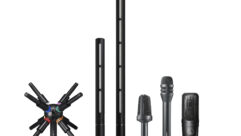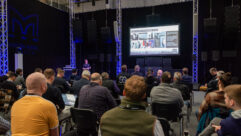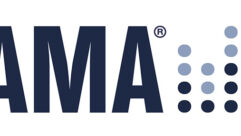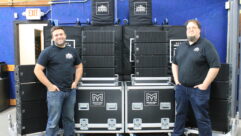

The goal of audio transmission is straightforward: move the waveform from sender to receiver as fast and faithfully as possible. Our challenge is to minimize unsolicited modification of the waveform—added noise, frequency response changes, distortion, dropouts, excess latency, and alien invaders.
We start with the transmitted product—the signal or waveform. The journey begins at the source, travels through (or over) the medium, and arrives at the receiver. The acoustic waveform is pressure variations over time, and our focus will be transmission through air. The senders are acoustic sources and loudspeakers, while the receivers are ears and microphones. The analog electronic version is voltage over time, which propagates through the electromagnetic medium. Device outputs and inputs are the sources and receivers. In the digital realm, a numerical encoding of the waveform is transmitted over a medium. The distinction between transmitting through a medium and over one might seem like splitting hairs but the two transmission forms are almost entirely distinct.
The remaining major pieces are transmission translation devices. In the analog world, these are transducers, whose role is to change between mediums. The digital corollary is the converter, which moves us between the analog and digital forms.
Our journey goes from Point A to Point A: Acoustic sender to acoustic receiver. There are lots of transmission paths to get there (Fig. 1).
● Acoustic to acoustic: Sound source to our ears, non-stop flight
● Acoustic to analog to acoustic: Add layovers at a mic, analog electronics, and speaker
● Acoustic to analog to digital to analog to acoustic: Insert a digital audio into the chain
● Acoustic to analog to digital to network digital to analog to acoustic: Move the digital audio over the net
THE ANALOG AUDIO PIPELINE
Prepare yourself for the “mother of all analogies.” We are going to use plumbing as the conduit for learning audio transmission in its various forms: analog, digital, and networked.
Direct current (DC) electrical circuits are often introduced to beginners in terms analogous to the flow of fluids through a pipe. Voltage is the water pressure at the source. Resistance relates to the pipe width and current is the liquid’s flow rate. Let’s modify that analogy to our favorite AC signal—audio transmission.
In our case, the pipeline is the containment vessel for the flowing waveform. The pipe casing represents the transmission system’s outer limits, since the waveform can’t expand beyond it. Our goal is to move the waveform through the pipe using as much of its open area as possible but never touching the casing. The pipe will vary in material and size as we go along, as will our flowing waveform. We want to move the waveform through a medium and/or transcribe it between mediums without modification. Three principal hazards lie in the analog path: distortion, noise, and frequency response modification.
Let’s examine a section of audio pipe. It can pass waveforms of limited size (amplitude) and no more. Anything larger hits the edges (clipping). There may be leaks in the casing that spill out (level loss), or allow other signals in (noise). The pumps (active electronics) keep things moving but also add noise. This internal circuit noise scales up or down with the pipe diameter. There are mechanical properties in the pipe casing, the hardness of the edges, the way it bends, the connectors, etc., that affect some portions of our waveform more than others (the frequency dependent effects).
Three lessons so far: an oversized waveform hits the walls, an undersized one is diluted with noise, and a pipeline made out of poor materials will be inefficient, noisy, and exhibit frequency dependent effects.
UPPER AND LOWER LIMITS
The pipeline analogy can be applied to a variety of audio media. The acoustics pipeline limits are pressure levels where transmission becomes increasingly non-linear with level. Distortion rises gradually with level and then increases sharply as the edge is neared. Visualize a slightly expandable hose under high pressure. By contrast, the analog electronic pipeline has a rigid casing set by the DC rail voltage (e.g. ±15VDC). Hitting it results in hard clipping of the waveform. Transformers and tape saturate the magnetic flux density, while speakers and microphones gradually reach the mechanical limits of their moving parts. These are softer forms of clipping. An overactive phonograph needle bursts the pipe and leaks into the next groove, and then it just won’t play-just won’t play-just won’t play.
The air pipeline is almost the same size everywhere (smallest on Mt. Everest). The analog electronic pipe comes in various sizes, roughly classified as mic, line, and speaker level. The waveform can never equal or exceed the DC rail voltages (or more accurately about 0.75V less than the rail). Rail voltages of 15VDC leave us with an absolute maximum AC swing of ±14.25VPK. For a sine wave that’s 10VRMS, also known as +20dBV (+22dBu). The DC rails (the pipeline size) are the primary factor in setting the maximum output capability of line level devices. It is difficult in practice to get through an entire device without some pinch points, so not all devices will necessarily make it up to the maximum theoretical level, but this is the trend. A thick pipe gives us more room than a thin one (e.g. 18VDC vs. 12VDC rails).
If ±14V is the standard line level pipe, then what is mic level? That’s a tricky one. There are lots of mic level devices with line level pipe, e.g. a mic preamp, the output of which needs to swing to full line level. Mic level only exists because microphones and guitar pickups, etc., put out extremely small amounts of level (not because we have a small DC power supply). A mic level device such as a guitar pedal can get away with a 9V battery (DC rails of around ±3.5V) because the audio waveform won’t exceed that pipe size. We will need bigger plumbing later to step it up to line level.
There is a 6dB difference in maximum swing between line level pipes with internal diameters of ±11V and ±23V varieties (DC rails between 12V and 24V). This is substantial, but not exactly a game changer. Power amplifiers are another story. Line level input pipe connects to a much bigger one on the output.
IMPEDANCE: LOW Z SOURCE TO HIGH Z RECEIVER
Let’s send some signal into the pipe and see what we get at the other end. The source must be able to maintain enough flow (low impedance) to keep the pressure up in the medium. The receiver needs minimal flow (high impedance) to follow the pressure changes (the waveform transcription pattern).
The reversal, a high-impedance source feeding a low-impedance receiver is far from lossless, dynamically limited, and may possibly fail completely. Visualize this: We can drive a garden hose (or 10) with a fire hydrant with no worries about pressure loss (low Z source to high Z receiver). On the other hand, a garden hose could never generate enough flow to fill up a fire hose (high Z source to low Z receiver).
The acoustic pipeline is driven by low impedance devices (natural or loudspeakers) to our high impedance ears (or microphones). The analog electronic pipeline has several low Z source to high Z receiver iterations: mics to preamps, line outputs to line inputs, and amplifiers to speakers.

Figure 2. Introducing the analog audio pipeline
INTERSTAGE CONNECTIONS
Let’s connect two matched line level pipe sections in series (Fig. 2). The outer limit hasn’t changed, so the waveform fits just the same (a unity gain connection). We just need a stronger pump to keep the pressure up in the longer pipe.
If we connect our 14V pipe to a 7V pipe, the outer edges of our waveform (anything >7V) will be clipped at the entry to the new, smaller section. We need to rescale the waveform downward to fit it into the 7V pipe (a 50 percent reduction, -6dB). Either we limit the waveform to 7V for the entire pipe or run two different scales to properly size the waveform for the current pipe size. We waste 6dB of headroom if we don’t rescale since the 14V pipe section will perform as a 7V section (but with 14V section noise floor). The best noise immunity comes from rescaling as we go.
Mic level, line level, and speaker level are the major scaling break points but smaller increments can be used, as well (Fig. 3). A mic preamp’s role is to rescale from mic to line level. This first circuit on a mix console prevents mic level signals from being moved through line level pipes where they would drown in the noise.

Figure 3. Analog pipeline: Mic, line, and speaker levels
SUMMING
What happens when we join two 14V pipes (A and B) at a junction that flows into a single 14V pipe (AB)? Matched waveforms will cause pipe AB to handle 2x the voltage of A (or B) individually (Fig. 4). Therefore we will overflow the AB section if we exceed 7V at A (or B). The solution is easy here: rescale both A and B down by 50 percent (6dB) at the junction, and AB will have the same amount of headroom as the individual sections.
We can assume that the A and B signals are different, since there is no good reason to sum identical analog electronic signals. This leads to a wild card situation where a new combined waveform is created. A moment of amplitude and phase matching can double the individual levels. But it can also be far less, perhaps even perfect cancellation, if we have a moment of equal amplitude and opposite (180 degree) phase. The average combination over time of two uncorrelated signals at equal level will be about 1.4x (+3dB) above the amplitude of the individuals. It is certain that the new waveform will be subject to change without notice and there is the looming possibility of a momentary 6dB increase. We must assume the worst to ensure our combined signal is safe from overload. This is where the concept of “headroom” in comes into play. We build in headroom wherever we have unknown dynamic conditions. Whereas unity gain was the logical choice for connections involving a single channel stream, this is not necessarily the case for summing junctions, which can be easily flooded if the multiple streams that feed a junction point are equal in size to the output. Visualize a plumbing system with six 1in. pipes joined together into a 1in. output pipe. This is a recipe for overflow, which is why no plumber would ever allow it. Downstream output pipes are made larger in the world of water. In the line-level audio world we stick with the same pipe size through the entire analog signal chain from the mic preamp to the power amp drive stage. Stepping up from 15VDC to 18VDC rails is an increase of only 2dB, which is less than the added flow we get from adding one input (3dB). We often connect 100 same-size line level pipes through multiple junctions (it’s called a mix console). At +3dB gain (1.4x) per doubling of inputs, we could face summation gain of 20dB (100x). How can we move this variable sized payload through the fixed-size pipeline system? The key is to scale down the level at the summing junctions. Send optimally loaded pipes toward the junction but throttle down the level at the summing junction to size the combined waveform for the output pipe. This in turn becomes an input pipe to the next stage, which is rescaled down again to keep the output in bounds. We seek consistent dynamic range through the various stages, even as signal density increases and the risk of huge peak-to-peak transient surges becomes greater. The upper side of dynamic range is headroom, and the lower side is noise floor. We preserve headroom and minimize noise by rescaling levels at the appropriate places.

Figure 4. Analog pipeline summing scenarios
HEADROOM
Headroom is the answer to the question: How close are we to overload? For studio mastering of recorded material there’s no mystery. Mastering engineers can find the maximum peak-to-peak levels reached in a track with an oscilloscope. Levels are set to ensure the final mix has the hottest possible level that fits cleanly in the pipe. Headroom is a realtime ongoing guesstimate for live sound, since we don’t know what the next moment will bring. Therefore, we need plenty of it. Competent operation can prevent a single channel from being driven into the rails but combinations of signals can lead to unexpected levels. Two properly scaled signals can combine to a level out of scale, due to momentary waveform summing (the reason we downscale at the entry to the summer). Returning to our plumbing analogy, we have a valve located at the summing junction to regulate flow into the output pipe. Reducing the gain here also helps preserve the noise floor because the inputs are scaled down along with their noise. Think of the alternative: operating all of our inputs at very low levels (and tons of headroom) so that we still have headroom after summing. This would leave us doing a unity sum of lots of noisy channels. The signal would rise, as would the noise. Instead, it may be better to reduce the individual inputs, which enter cleanly into the summer. There are so many places where the pipe can be overloaded: single stream gain stages or any summing stage (mix buses, aux buses, matrices, etc.).
PIPELINE FORMS
The features described here have various forms through the audio transmission chain. Each faces unique challenges due to the nature and limitations of the media and devices. Acoustic transmission propagates through air, which has a host of wild variables such as wind, refraction, reflections, and much more. The analog electronic pipeline, by contrast is a fairly simple construct until it comes time to start pushing a speaker back and forth. Digital audio and digital networking package the mathematically encoded audio and ship it. Acoustic, analog and digital each have unique transmission pipelines, which will be covered in the next parts of this article.










